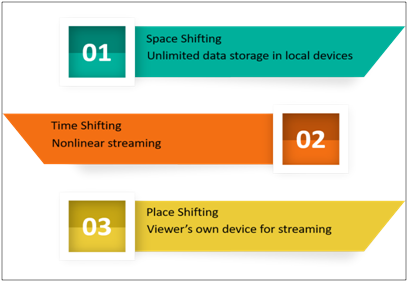OTT: Reimagining Business Dynamics in Media & Entertainment
The exponential growth in internet-based TV content is realigning the distribution models, consumer habits and advertising business in the media and entertainment (M&E) industry. There is increasing need for on-demand and original content. In the past few years, pay television is witnessing severe competition from Over The Top (OTT) as consumers are rapidly shifting towards this business model.
What is OTT?
OTT is defined as delivery of video content through fixed or mobile broadband internet connections instead of the traditional broadcast TV spectrum or dedicated cable, fiber, or satellite networks. The proliferation of smart phones, better internet speeds, and better connectivity has led to the surge of OTT streaming. Research indicates that OTT revenues are expected to reach USD 16.6 billion in 2018 – a 40% increase over 2017, and close to USD 26 billion by 2020. OTT is an extremely high growth and continuously changing arena for the M&E industry. Content viewing is being transformed and disrupted at a breath-taking pace, leading to rapid decline in traditional pay-tv viewing concept.
The industry is also on the cusp of major digital transformational change due to the proliferation of consumer touch points and advent of enablers such as Artificial Intelligence (AI), Blockchain, Analytics and Virtual Reality/Augmented Reality (VR/AR). In short, the advent of OTT has brought a paradigm shift in consumers’ viewing habits.
The following are the three trends we see emerging:

Is OTT really a competition?
The broadcasting industry is stepping into an “OTT 2.0” era. According to research by Parks Associates, 52% of US broadband households subscribe to both pay TV and one or more OTT services. There is now increasing ‘competition’ rather than competition among the two models. Broadcasting houses having learned lessons from OTT platforms and are now strategizing to meet new business demands and opportunities with more original digital content, more direct offerings to consumers, more data, and more advanced technologies. The fact that big names such as Disney, HBO and CBS have ventured into the OTT space is evidence enough.
In such a dynamic and ever changing scenario, there are ever-evolving business models. Some of the successful ones are:
- Transaction-Supported Services: Content is available to own or rent for a one-time fee. E.g. Amazon Instant Video.
- Advertising-Supported Services: These services offer free access to large libraries of movies, TV shows, clips, and other live or on-demand content from professional as well as amateur content creators. E.g. Hulu.
- Subscription-Supported Services: For a monthly fee, services in this group offer access to a library of content and distributed via streaming. E.g. Netflix, Amazon Prime Video, HBO Go.
- Digital Multichannel Video Programming Distributors – DMVPDs are also subscription services, but they replicate the traditional cable bundle in a digital context, essentially bundling and selling online a set of live and on-demand services. E.g. Dish Network’s Sling TV.
OTT is clearly the next big thing and major broadcasters can’t afford to wait and watch. Broadcasting companies cannot afford to miss this opportunity to build a sustainable competitive advantage. The future of TV will combine the power of linear and OTT. Dynamic and non-traditional partnerships, out of the box business models and unique revenue models are the future of the media and entertainment industry. As video viewing and consumption evolves, leveraging this combined power of linear and OTT will determine the success of the players in this industry.
Latest Blogs
A closer look at Kimi K2 Thinking, an open agentic model that pushes autonomy, security, and…
We live in an era where data drives every strategic shift, fuels every decision, and informs…
The Evolution of Third-Party Risk: When Trust Meets Technology Not long ago, third-party risk…
Today, media and entertainment are changing quickly. The combination of artificial intelligence,…




